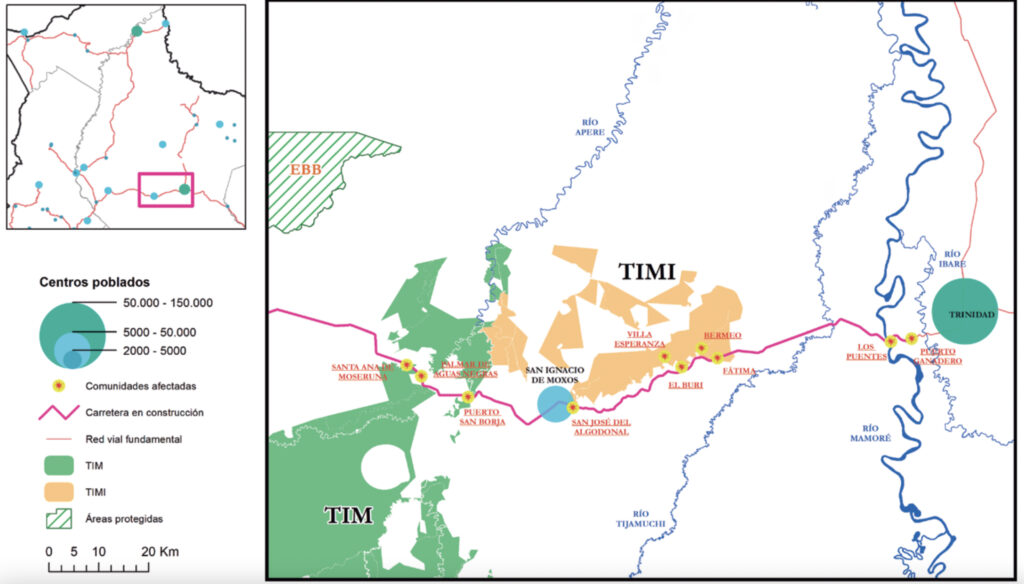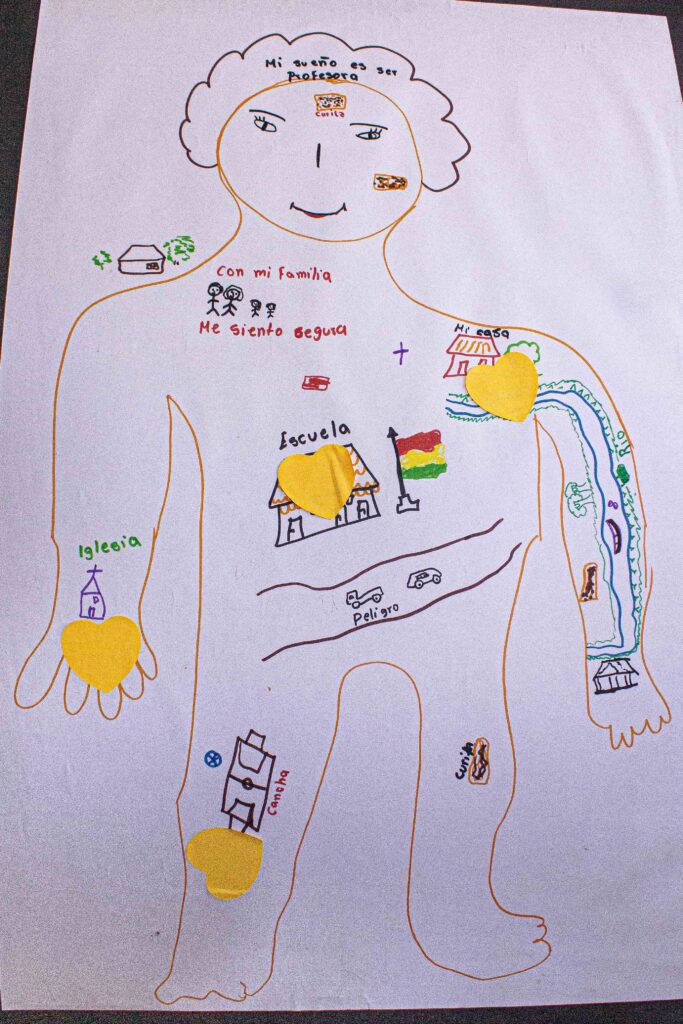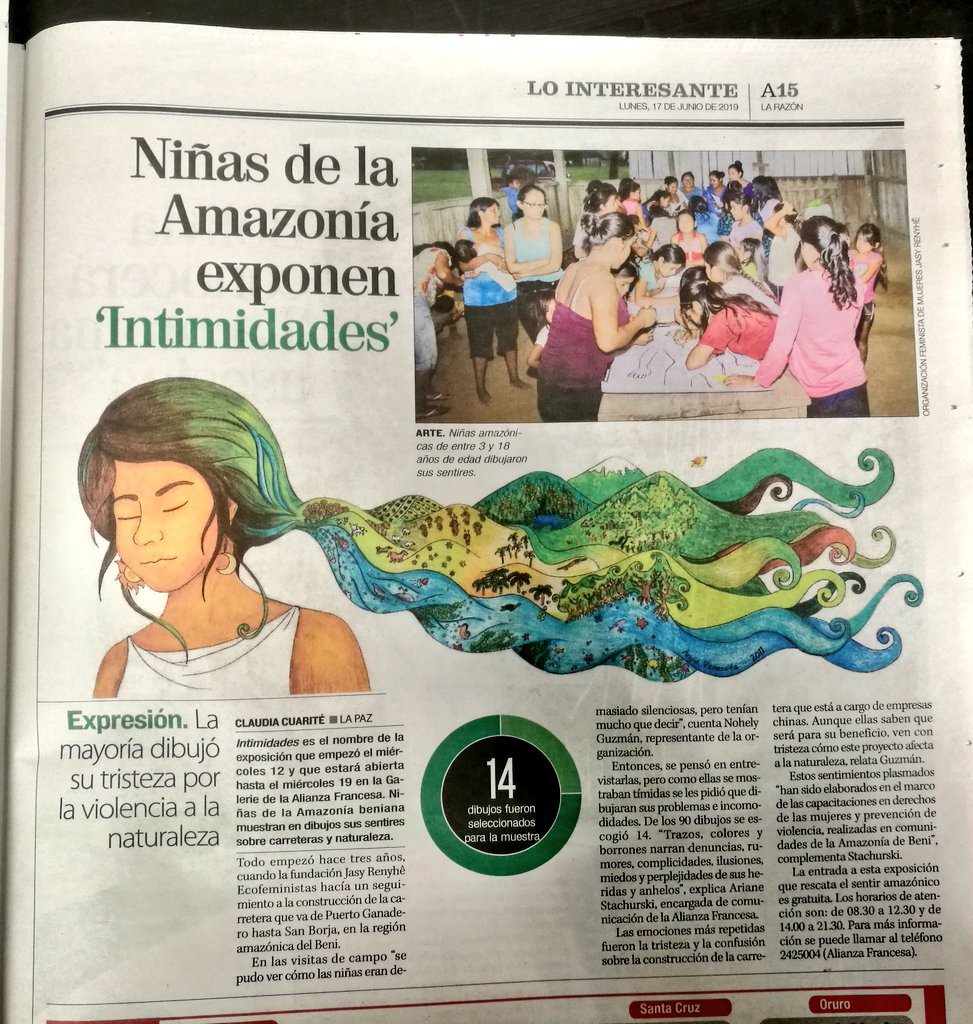
By NOHELY GUZMÁN NARVÁEZ
IN MARCH 2019, I had one of the most nurturing, delicate, and vulnerable experiences of my professional career. After years of having worked with Indigenous women from the Bolivian Amazon in whose territories Chinese capital has settled, I learned that the body knows, feels, and speaks in ways that cannot always be named. That month, the women and girls of Santa Ana de Museruna in Beni, Bolivia, where the Chinese CCCC Second Highway Engineering Co., Ltd., is building the San Ignacio de Moxos–San Borja highway, showed me that many paths in the heart of the Amazon are made of feelings. Feeling, and walking their territories with them, was the only way for me to comprehend what the deforestation charts or the figures on Bolivian foreign debt with China hid about life in the Amazon.
This piece is a reflection on the politics of care in-and-as research that were part of my master’s thesis in Latin American Studies at The University of Texas at Austin. In what follows, I examine the methodological proposal I have developed in collaboration with Santa Ana’s Indigenous women and girls to make sense of the geographies traced by their bodies and emotions in their encounter with transnational capitalism. Body-mapping is based on the premise that the body is the main geographical site where our experiences of, with, and in the world converge. As such, I argue that by mapping the body and how it feels (in) certain places, we gain a privileged spatial perspective. Body-mapping, in this sense, consists of locating in the body the places where we feel specific places, and how we feel them.
Examining the body-mapping methodology itself, however, calls for situating my research with Santa Ana’s Indigenous women and girls along this highway in the context that led me to this project. The San Ignacio–San Borja highway crosses Indigenous territories of Moxeño, Moxeño-trinitario, Yurakares, Tsimanes, and Movimas peoples (Díez 2011; Guzmán 2021). This area, in which the Territorio Indígena Multiétnico I (Multiethnic Indigenous Territory I, TIM I for its initials in Spanish), the Territorio Indígena Moxeño Ignaciano (Moxeño Ignaciano Indigenous Territory, TIMI for its initials in Spanish), and the Territorio Indígena Chimán (Chimán Indigenous Territory, TICH for its initials in Spanish) collide, is one of the regions most densely populated by Indigenous communities in Bolivia (Figure 1). But what do geopolitical processes and transnational capital mean for these communities?

The San Ignacio–San Borja highway, as one of the only routes that connects Western and Eastern Bolivia in that area, has operated as a strategic window for me to observe the local, national, and transnational dynamics of capital currently led by China in the region. Although the economic and geopolitical aspect of this process has piqued the interest of an increasing number of academics and policy makers, few have been the cases in which the local communities and their experiences have been at the center of these studies. In the time I spent between Rurrenabaque and Puerto Varador in Beni since late 2016, however, I was able to observe those dynamics at play and on different scales. In the midst of Indigenous territories where Chinese flags and signs written in Mandarin were raised, I realized that the majority of China’s financed projects take root in Indigenous territories, national parks, and protected areas (Ray, Gallagher, and Sanborn 2019). It was in this puzzling context that I developed the methodological proposal of the body-mapping that I discuss here.
The Body as Territory
In the last few years, I have spent time with Indigenous communities, and particularly Indigenous women and girls, who have shown me that methods such as the semi-structured interviews I was conducting were not enough to fully comprehend their experiences. Long before the deployment of the body-mapping idea, “I had spent time observing, walking, listening, and feeling the territory about which I had heard a lot and very little at once” (Guzmán 2021: 56). “Wildlife trafficking, pollution, complaints of violations of labor rights, and silent cases of sexual violence against indigenous women had led me there. But what was really happening?” (56).
“Se le nota en los ojos” (“It shows in her eyes”) were words I often heard when talking about women’s experiences with the recently settled Chinese company in their territories (Guzmán 2021: 56). “De solo verlos se me eriza la piel” (Just seeing [the workers] gives me goosebumps), among other comments of a similar nature, pointed to a joint, amalgamated, and indivisible experience of what in the eyes of everyone else was external, material, and disembodied stuff. In other words, it was not always possible to find words to describe the feelings that existed on a corporal level.
Trying to make sense of these experiences, I found Maya-Xinka author Lorena Cabnal’s (2010) theorization of cuerpo-territorio (body-territory). Along with Cabnal, Aymara feminist Adriana Guzmán (2014) and Seneca theorist Mishuana Goeman (2013) have taught me that capitalist processes are never race-, gender-, or ethnicity-neutral (Guzmán 2021: 46). Stemming from this, and adding age to the conversations on this body of knowledge, I revist Cabnal’s proposal of cuerpo-territorio as a single term expressing unity. Understanding the body as a territory, and the territory as a body, Cabnal asserts: “The historical and oppressive violence exists for both my first territory-body, as well as for my historical territory, the land” (23). Through this framework, and in conversation with Goeman’s insistence on Indigenous women’s “spatial embodiment of knowledge” (16) I understood that it was within the body that the physicality of the land, the marks of the colonial, capitalist, patriarchal practice of empires, and the body’s most sensitive fibers were tied (Guzmán 2021: 6). As such, I proposed mapping to Santa Ana’s Indigenous women and girls. But how does one map feelings?
None of the mapping techniques I had heard of up to that point were useful to answer the questions I could not even articulate. Traditional geographical and mapping methods have historically made many assumptions about the subjects, spaces, places, scales, and meanings in which territories are organized. Reflecting on the importance of not only flipping the script but rather engaging with the act of listening seriously, I started reimagining the scales, terms, meanings, and logics of what gave rise to a feminist, community-centered, and liberating academic grammar. In this context, I asked: Which methodological approach, sensitive to the emotional and independent of words, would allow the expression of the feelings, emotions, and place-making experiences that were structuring the body and territory of Santa Ana’s women and girls as they undergo capitalist-driven transformations? (Guzmán 2021). This question, along with my observations and conversations in the field, evoked anthropologist Nancy Scheper-Hughes’s words to guide me through little-explored terrain: “Seeing, listening, touching, recording, can be, if done with care and sensitivity, acts of fraternity and sisterhood, acts of solidarity. Above all, they are the work of recognition. Not to look, not to touch, not to record, can be the hostile act, the act of indifference and of turning away” (2005: 43).

With these words in mind, and after having discussed the prompts and protocols guiding the workshop with some of the Indigenous women leaders, the community’s women and girls began to draw their body maps. In them, we can observe, for example, the sites where they feel joy both bodily and with regards to the “external” physical places that evoke those emotions, sensations, and feelings. At home with their families, the girls affirm they feel happy and safe. Similar emotions are present with regards to the school, the field, and the church. On their maps, we can also see the sites of, and in, pain. Nature is particularly highlighted. The pollution that is caused mostly by the company, the dead animals along the highway, the band-aids on the hurt rivers and trees—these are some of the places marked as suffering and painful. Furthermore, the maps display the places where the girls feel fear: in the stomach when walking alone around the highway, or in the chest when the company’s trucks and cars drive by with people they do not know.
Maps like the one in Figure 2 were drawn by a group of Indigenous girls who participated in a four-hour body-mapping workshop I organized in March 2019. Both during the process of crafting the questionnaire and drawing the maps, it was inevitable to think of Katherine McKittrick (2006: 46) and her incisive proposal that merges the material geographies in “the scale of the body” as a “location of politization.” It is precisely with that politization in mind that I think of research as a space of contention and of negotiation. In the body-mapping of cuerpo-territorio, I was able to see this in motion.

The image in Figure 3, from a Bolivian newspaper, is the result of one of those negotiations, as toward the end of the body-mapping workshop, one of the girls who participated raised her hand to ask me where the maps were going to be displayed. Surprised, I answered that no one but us was going to see the maps. She responded that this was sad and disappointing. Pointing at her map, she said, “but our maps are so pretty and we’ve worked so hard on them” (Guzmán 2021: 77). After a few months, along with Jasy Renyhê, the feminist organization of which I am a co-founder, I was able to stage and exhibit the girls’ maps for a few weeks in an art gallery in La Paz, Bolivia. Although the girls could not attend the exhibition opening themselves due to travel constraints at their young ages, my colleagues Paola S., Adriana R., Laura A., and I made sure to address the comments that they had pointed out and highlighted for the presentation.
Final Thoughts: Politics of Care in-and-as Research
As I hope to have shared in this brief piece, I have learned that body-mapping, when done with-and-as care, can allow us to reinvent an academic grammar that accounts for the body as “our most immediate and intimate geography” (Rocheleau, Thomas-Slayter, and Edmunds 1994: 90). This experience, echoing David Hodge (1995: 426), confirms that “methods are powerful extensions of epistemological and ontological positions.” My experience with body-mapping, furthermore, displays the ways in which the material “extends into the body as a site of material reproduction” of what is traditionally seen as exclusively external (Nightingale 2011: 154–155). Methodologies centered on the body, and similar logics of body-maps, have also been extensively examined by Latin American grassroots organizations such as the Colectivo Miradas Críticas del Territorio desde el Feminismo, Colectivo Geobrujas, and Colectivo de Geografía Crítica de Ecuador. Undoubtedly, the work I present here has been inspired by and derives from the Latin American tradition of popular education of which these organizations are an example. As such, I like to think of them as mentors and cómplices of my thought and praxis. Finally, with the hope that this piece raises curiosities that impact our thought and praxis in and beyond academia, I want to bring to the fore Anna Tsing’s words (2011: 5) to think of research and knowledge production more broadly:
A wheel turns because of its encounter with the surface of the road; spinning in the air it goes nowhere. Rubbing two sticks together produces heat and light; one stick alone is just a stick. In both cases, it is friction that produces movement, action, effect. ✹
Nohely Guzmán Narváez is a PhD student in geography at the University of California, Los Angeles. A graduate of the LLILAS master’s program in 2021, she won the Best Thesis Award for “‘Esta carretera nos atraviesa’: Indigenous girls’ body-territory mapping in the emergence of Chinese capital in the Bolivian Amazon.”
Angie Vanessita is a visual artist and activist based in Quito, Ecuador. View her work at www.angievanessita.com and follow her on social media at @angie.vanessita.
References
Cabnal, L. 2010. Feminismos diversos: el feminismo comunitario. Barcelona: Asociación para la cooperación con el Sur (ACSUR).
Colectivo de Geografia Crítica del Ecuador. 2018. “Geografiando para la Resistencia: Los feminismos como práctica espacial.” Cartilla 3. Quito.
Colectivo Miradas Críticas del Territorio desde el Feminismo. 2017. Cuerpos, Territorios, y Feminismos. Grupo de Trabajo de CLACSO.
Díez, Á. 2011. Compendio de etnias indígenas y ecoregiónes: Amazonía, Oriente y Chaco. La Paz: CESA.
Goeman, M. 2013. Mark My Words: Native Women Mapping Our Nations. Minneapolis: University of Minnesota Press.
Guzmán, A. 2014. El Tejido de la Rebeldía. ¿Qué es el feminismo comunitario? La Paz: Comunidad de Mujeres Creando Comunidad.
Guzmán, N. 2018. Capitalismo chino en la selva: los cuerpos desechables detrás de tres obras de infraestructura en Bolivia. Bolivia: FOBOMADE.
———. 2021. “‘Esta carretera nos atraviesa’: Indigenous girls’ body-territory mapping in the emergence of Chinese capital in the Bolivian Amazon.” Master’s thesis. Austin: The University of Texas at Austin.
Hodge, D. 1995. “Should Women Count? The Role of Quantitative Methodology in Feminist Geographic Research.” The Professional Geographer 47 (4): 426.
Nightingale, A. 2011. “Bounding difference: Intersectionality and the material production of gender, caste, class and environment in Nepal.” Geoforum 42 (2): 153–162.
Ray, R., K. Gallagher, and C. Sanborn, eds. 2019. Development Banks and Sustainability in the Andean Amazon. 1st ed. New York: Routledge. doi.org/10.4324/9780429330193
Rocheleau, D., B. Thomas-Slayter, and D. Edmunds. 1995. “Gendered Resource Mapping: Focusing on Women’s Spaces in the Landscape.” Cultural Survival Quarterly (Winter 1994): 177–183.
Rocheleau, D., B. Thomas-Slayter, and E. Wangari. 1996. “Gender and environment: A feminist political ecology perspective.” In Feminist Political Ecology: Global Issues and Local Experiences, 3–26. London and New York: Routledge.
Scheper-Hughes, N. 2005. “Death Squads and Democracy in Northeast Brazil.” In 2005 Report of The Harry Frank Guggenheim Foundation.
Tsing, A. 2011 (E-book). Friction: An Ethnography of Global Connection. Princeton; Oxford: Princeton University Press.
